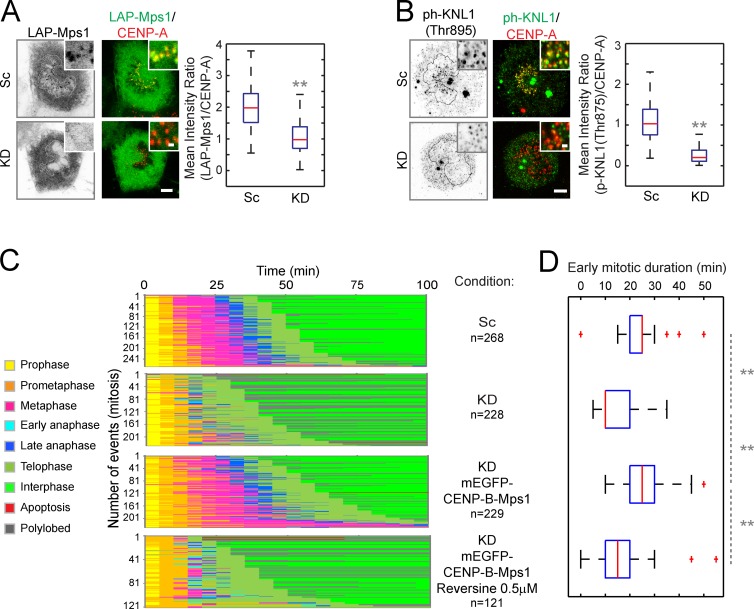Figure 6.
ARHGEF17 is required for targeting of Mps1 at kinetochores, and constitutive tethering of Mps1 to the kinetochore replaces ARHGEF17’s SAC function. (A and B, left) Exemplary prometaphase cells with LAP-Mps1 and phospho-KNL1 labeled at kinetochores. Overlay shows LAP-Mps1 (A) or ph-KNL1 (Thr875; B; green) and CENP-A (red) after knockdown of ARHGEF17. (insets) High magnification of kinetochores. (right) Quantitative ratiometric comparison of LAP-Mps1 (A) or ph-KNL1 (B). Box plot comparing the mean intensity ratio between LAP-Mps1/CENP-A or ph-KNL1/CENP-A ratio of >600 individual sister kinetochores/three independent experiments. Bars: (main) 5 µm; (insets) 0.5 µm. (C and D) Phenotypic rescue by artificial kinetochore tethering of Mps1 in the absence of ARHGEF17. (C) Mitotic events were automatically extracted after knockdown in cells stably expressing H2B-mCherry and mEGFP-CENP-B-Mps1 with or without 0.5 µM reversine treatment. Colors indicate H2B-mCherry morphology classes. (D) Comparison of early mitotic duration. Box plot comparing the duration of prometaphase and metaphase in each condition. Mean and standard deviation of >120 mitotic events (n indicated for each condition)/three independent experiments. Boxes show median, 25–75%; whiskers show 1.5× interquartile range. **, P < 0.01 by two-tailed unpaired Student’s t test, compared with si(Scrambled) (A and B), si(Scrambled) versus si(ARHGEF17); si(hARHGEF17) versus mEGFP-CENP-B-Mps1 expression with or without reversine (D). Sc, Scrambled; KD, knockdown.

